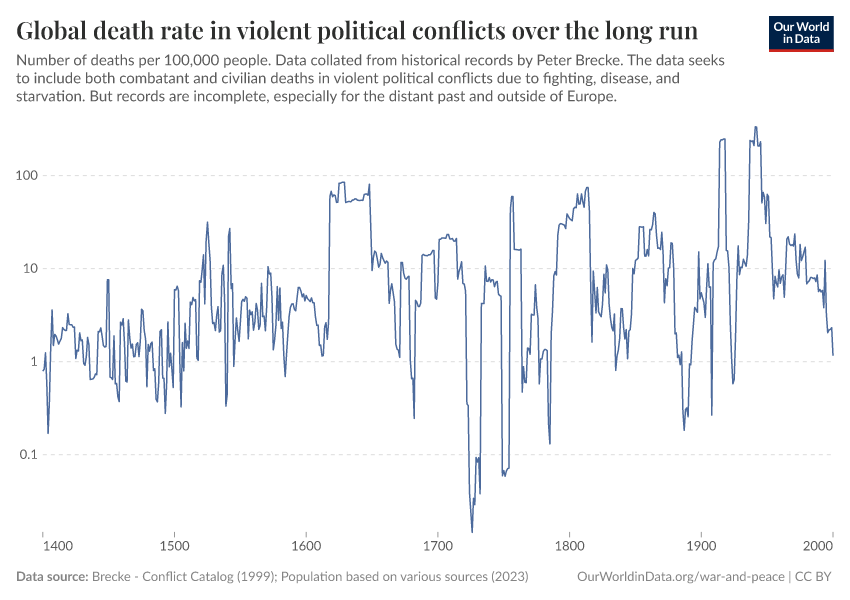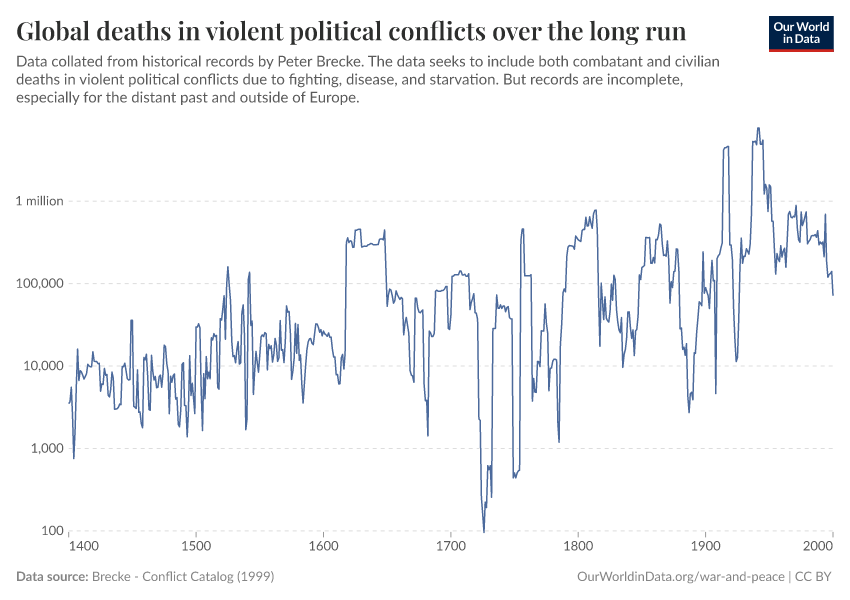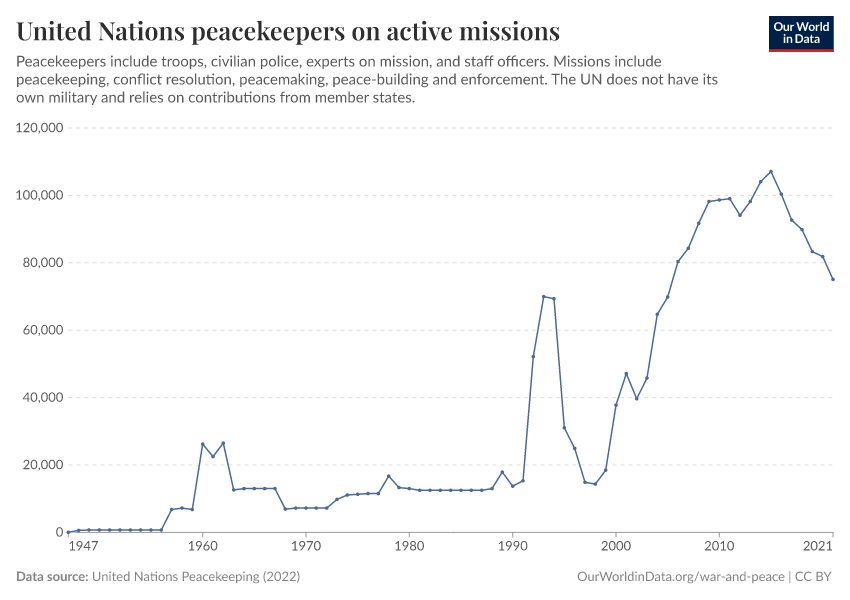War and Peace
Since 1800, more than 37 million people worldwide have died while actively fighting in wars.
The number would be much higher still if it also considered the civilians who died due to the fighting, the increased number of deaths from hunger and disease resulting from these conflicts, and the deaths in smaller conflicts that are not considered wars.1
Wars are also terrible in many other ways: they make people’s lives insecure, lower their living standards, destroy the environment, and, if fought between countries armed with nuclear weapons, can be an existential threat to humanity.
Looking at the news alone, it can be difficult to understand whether more or less people are dying as a result of war than in the past. One has to rely on statistics that are carefully collected so that they can be compared over time.
While every war is a tragedy, the data suggests that fewer people died in conflicts in recent decades than in most of the 20th century. Countries have also built more peaceful relations between and within them.
How many wars are avoided, and whether the trend of fewer deaths in them continues, is up to our own actions. Conflict deaths recently increased in the Middle East, Africa, and Europe, stressing that the future of these trends is uncertain.
On this page, you can find data, visualizations, and writing on how common war and peace are between and within countries, and how this has changed over time.
Research & Writing
July 15, 2024
Millions have died in conflicts since the Cold War; most of them in Africa and intrastate conflicts
Deaths in the Middle East and deaths from violence targeting civilians have also been common.
October 13, 2023
How major sources collect data on conflicts and conflict deaths, and when to use which one
There are many ways to measure armed conflicts and conflict deaths. What approaches do different researchers take? And when is which approach best?
October 20, 2023
How different measures capture how common and deadly conflicts are, and when to use which one
There are several ways to capture how common and deadly armed conflicts are. What are they? And when is which measure best?
Explore Data on Armed Conflict and War
Our team has created two additional Data Explorers to make even more data on armed conflicts and war easier to access and understand. They provide and explain data from six leading datasets: on how deadly and common they are, which countries are involved, and where they take place. You can learn more about which measure and data source can best answer your questions in our articles explaining the metrics and datasets.
Key Charts on War & Peace
See all charts on this topicAcknowledgements
We thank Saloni Dattani, Charlie Giattino, Joe Hasell, Edouard Mathieu, Esteban Ortiz-Ospina, Valerie Rogers Muigai, and Veronika Samborska for their helpful suggestions and ideas.
Endnotes
These additions bring the estimated death toll for the 20th century alone to around 110 million people.
Wimmer, Andreas. 2014. War. Annual Review of Sociology 40: 173-197, citing:
Eckhart, William. 1992. Civilizations, Empires and Wars: A Quantitative History. McFarland.
Lyall, Jason. 2020. Divided Armies: Inequality and Battlefield Performance in Modern War. Princeton University Press.
You can take a closer look at them in our bar chart on wars ranked by their death toll, which allows you to select the wars you are interested in.
Braumoeller, Bear. 2019. Only the Dead: The Persistence of War in the Modern Age.
Spagat, Michael, and Stijn van Weezel. 2020. The Decline of War since 1950: New Evidence. In: Nils Petter Gleditsch. Lewis Fry Richardson: His Intellectual Legacy and Influence in the Social Science.
Davies, Shawn, Garoun Engström, Therese Pettersson, and Magnus Öberg. 2024. Organized violence 1989-2023, and the prevalence of organized crime groups. Journal of Peace Research 61(4): 673-693.
Lacina, Bethany, and Nils Petter Gleditsch. 2005. Monitoring Trends in Global Combat: A New Dataset of Battle Deaths. European Journal of Population 21: 145-166.
START (National Consortium for the Study of Terrorism and Responses to Terrorism). 2021. Global Terrorism Database (GTD) [Data set]. University of Maryland.
Galtung, Johan. 1969. Violence, Peace, and Peace Research. Journal of Peace Research 6(3): 167-191.
The share of peaceful relationships also increases when country-pairs without a relationship are included.
Cite this work
Our articles and data visualizations rely on work from many different people and organizations. When citing this topic page, please also cite the underlying data sources. This topic page can be cited as:
Bastian Herre, Lucas Rodés-Guirao, and Max Roser (2024) - “War and Peace” Published online at OurWorldinData.org. Retrieved from: 'https://ourworldindata.org/war-and-peace' [Online Resource]BibTeX citation
@article{owid-war-and-peace,
author = {Bastian Herre and Lucas Rodés-Guirao and Max Roser},
title = {War and Peace},
journal = {Our World in Data},
year = {2024},
note = {https://ourworldindata.org/war-and-peace}
}Reuse this work freely
All visualizations, data, and code produced by Our World in Data are completely open access under the Creative Commons BY license. You have the permission to use, distribute, and reproduce these in any medium, provided the source and authors are credited.
The data produced by third parties and made available by Our World in Data is subject to the license terms from the original third-party authors. We will always indicate the original source of the data in our documentation, so you should always check the license of any such third-party data before use and redistribution.
All of our charts can be embedded in any site.


























































